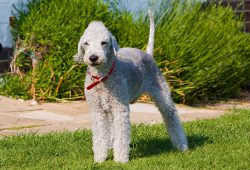The Bedlington Terrier is a breed of small dog named after the mining town of Bedlington, [wiki base=”EN”]Northumberland[/wiki] in North East England. Originally bred to hunt vermin in mines, the Bedlington Terrier has since been used in dog racing, numerous dog sports, as well as in conformation shows and as a companion dog. It is closely related to the Dandie Dinmont Terrier, Whippet and Otterhound.
It is described as a very versatile yet contradictory dog, being both good with children and “fit to kill any other dog of his weight”. They have powerful swimming skills, comparable to those of water dogs such as the Newfoundland, and are noted for being very quick and having high endurance. Bedlingtons are noted for their similarity in appearance to lambs. The dogs have blue, liver or sandy colouration, all three of which may have tan points. Their fur forms a distinctive top knot on the dog’s head.
Description
Appearance
The Bedlington Terrier has been described as resembling a lamb. It has also been compared to a miniature version of the Scottish Deerhound. George Shields stated that exceedingly well-bred dogs possess the spirit of a thoroughbred [wiki title=”Horse_racing” base=”EN”]racehorse[/wiki].
The dogs have blue, liver or sandy colouration, all three of which may have tan points. Bedlingtons carry what is known as the greying gene, a [wiki title=”Dominance_(genetics)” base=”EN”]dominant[/wiki] trait carried on the G [wiki title=”Locus_(genetics)” base=”EN”]locus[/wiki]. This gene causes puppies born with black or dark brown fur to lighten to grey or liver with age. The fur of the Bedlington creates a shape on the top of the dog’s head known as a topknot. Although most modern breed standards call for the dog’s topknot to be lighter than its body, when the breed was first being formed there was at least one prominent breeder, Mr. Pickett, who believed that the topknot should be darker, not lighter.
Temperament
Bedlingtons are sharp and plucky. Their bark has been called hound-like and has been compared to the firing of a machine gun. Fast dogs with high endurance, the Bedlington Terrier is just as quick in water as it is on land, and their swimming speed rivals that of the Newfoundland.
They are also known for their intelligence and tenacity when it comes to taking on vermin. Bedlingtons are quite fond of fighting, and are prone to jealousy when around other dogs. One man stated that “this dog was about fit to kill any other dog of his weight” and compared him to the fighting dogs used in dog fighting.
Health
Longevity
Median longevity of Bedlington Terriers, based on two recent UK surveys, is about 13.5 years, which is longer than for purebred dogs in general and longer than most breeds similar in size. The longest-lived of 48 deceased dogs in a 2004 UK Kennel Club survey was 18.4 years. Leading causes of death among Bedlington Terriers in the UK were old age (23%), urologic (15%), and hepatic (12.5%). The leading “hepatic” cause of death was copper toxicosis. Dogs that died of liver diseases usually died at a younger age than dogs dying of most other causes.
Copper toxicosis
Copper toxicosis, also known as copper storage disease and copper overload syndrome, is an [wiki title=”Autosome” base=”EN”]autosomal[/wiki] recessive [wiki title=”Disease” base=”EN”]disease[/wiki] that is characterized by an accumulation of copper in the liver. It is closely related to [wiki base=”EN”]Wilson’s disease[/wiki] in humans. Bedlington Terriers are more prone to copper toxicosis than most other dog breeds. West Highland White Terriers, Skye Terriers, and Doberman Pinschers are also prone to copper storage disease. Bedlington Terriers are the only breed of dog in which [wiki title=”Hemolysis” base=”EN”]haemolysis[/wiki] has been reported, but there have been no reports of neurological involvement in any dog breed.
Bedlington Terrier. (2017, March 19). In Wikipedia, The Free Encyclopedia. Retrieved from https://en.wikipedia.org/w/index.php?title=Bedlington_Terrier&oldid=771063013


